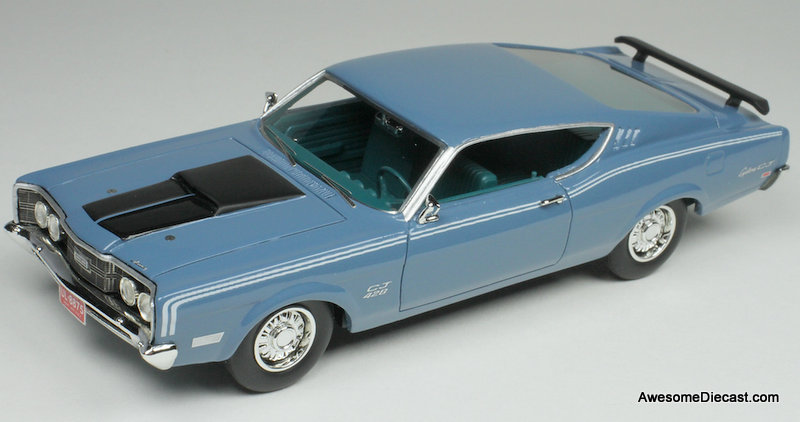Goldvarg Collection
Goldvarg Collection 1:43 1969 Mercury Cyclone, Dark Aqua Poly

Goldvarg Collection 1:43 1969 Mercury Cyclone, Dark Aqua Poly
€87.31
These are limited edition models with only 170 pieces distributed worldwide
The Mercury Cyclone is an automobile that was marketed by the Mercury division of Ford from 1964 to 1971. Introduced in 1964 as the Mercury Comet Cyclone, the Cyclone replaced the S-22 as the performance-oriented version of the Mercury Comet model line. The Cyclone became a distinct nameplate for the 1968 model year, as the Mercury Montego was phased in to replace the Comet.
Within Mercury, the Cyclone was slotted between the Cougar pony car and the Marquis/Marauder full-size two-doors. Though largely overshadowed by the Cougar, the Cyclone was positioned as a muscle car, representing the Mercury brand in racing.
Four generations of the Cyclone were produced, with production ending after the 1971 model year. For the 1972 model year, the Cyclone returned as an option package for the Montego; only 30 examples were produced. Within the Mercury line, the Cyclone was not directly replaced. The Cougar XR7 was repackaged as a personal luxury version of the Montego for 1974.
The Cyclone started as an option for the 1964 Mercury Comet. It featured a 289 cu in (4,736 cc), 210 hp (156.6 kW) engine and a sporty look. In the 1965 models, the engine was updated to the four-barrel carbureted version of the 289 cu in (4,736 cc) unit, but generated 200 hp. The 1966 models underwent a major styling change. The body received "sculpturing" that ran the length of the car, and was based on the body of the Ford Fairlane. The models introduced new engines. The 390 Y code was a 390 cu in (6,391 cc) engine with a two-barrel carburetor and 265 hp (198 kW). The 390 H code had a four-barrel carburetor and 275 hp. The 1967 model was produced with several engine options. The standard engine was the 289 V8 with 289 cu in. The 1968 models dropped "Comet" from their name. The Cyclones had a mid tire level body tape stripe. The Cyclone GT's had an upper level body stripe, buckets, wide whitewall tires, special wheel covers, all vinyl interior, and the special handling package. It was named the fastest car of that year, because it set a world record speed of 189.22 mph (304.52 km/h) at Daytona. In 1969, the Cyclones had several engine options. Mercury produced a version of the Cyclone for NASCAR called the Cyclone Spoiler II. The model was available in two flavors. The street version featured a 351 cu in (5,752 cc) Windsor block, and was used to enter into the NASCAR business. The racing version featured a 429 cu in (7,030 cc) Boss block, which was the same engine as the one in the 1969 Boss Mustang. Mercury also added a new model to the Cyclone line: the Cobra Jet (CJ). The Cobra Jet's engine was a 428 cu in (7,014 cc) which generated 335 hp (250 kW). The engine had a Ram Air option, a 735 CFM Holley four-barrel carburetor although the option showed no quoted difference in horsepower rating. The Mercury Cyclone CJ had the following enhancements over the Cyclone and Cyclone GT: it had a blacked-out grille; dual exhausts; 3:50:1 axle ratio; engine dress-up kit (chromed parts); hood (bonnet) stripes; and a competition handling package.














